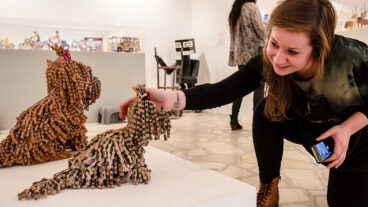A Passover Seder on a kibbutz is a modern link in the chain of history. I spent my childhood at Kibbutz Ramat Menashe. As a kibbutz kid I would wait all year for Pessah to come. The entire kibbutz was decked out for the holiday, we all wore white, the main kibbutz hall was set up to accommodate members and all their guests, it was packed to the rafters and very moving. The whole group would sit together and read the kibbutz Haggadah.
It’s tough to describe the feeling of togetherness, which is the true meaning of the holiday. As then, this year, too, the traditional kibbutz haggadah formed a central focus of the seder night, not only for some 100,000 kibbutzniks from the Galilee to Eilat, but also for thousands of Israeli city dwellers who find the modern-day work to be the best expression of their secular Jewish identity.
I say proudly that this Haggadah is one of the most important Jewish artistic creations of the 20th century. This is not really so surprising, because the authors of the kibbutz Haggadah were just about the only Jews of the 20th century who dared modernize age-old Jewish traditions. They soaked up the tradition and joint history we all share and asked themselves how these blended with the reality of our modern-day lives – and what needed to be added.
The kibbutz Haggadah was written by people who experienced their own exodus from Egypt. Perhaps because of this, it has been so successful at creating a feeling of continuity between the historical story of the Haggadah and the force of the events our people experienced during the previous century.
It was written by people who left their families and birth lands, and moved to the Land of Israel to re-create themselves. They sat around the seder table during the 1920s and 30s, close to the sites where the historical events took place but far removed from their families and traditional seder nights, and tried to reconnect, in an honest and direct way, to their Jewish roots.
In practice, they were searching for themselves and their personal-kibbutz-national stories among the holiday stories. In doing so, they created a new tradition.
A kibbutz Pessah is the creation of dedicated secularists, who believed they were taking part in something much larger. They did not see their modern lives as disconnected from thousands of years of Jewish history, but rather as a link in the chain.
They believed they were creating an artistic expression of their agricultural and settlement values, a Zionist document of the renewal of the Jewish people in its land, guided by one of the oldest Jewish texts in existence.
It is natural that creators of new traditions often try to remove themselves from old ones. Even though the authors of the kibbutz Haggadah based their work on the traditional text, a kibbutz seder spat in the face of more than a few traditional elements of the seder. For instance, many kibbutzim at leavened products at the seder table itself.
As the kibbutz movement matured and raised a new generation, seder night has become somewhat more traditional. We are still secularists who have no interest in rabbinic decrees, but seder night on today’s kibbutzim is more respectful of traditional symbols, which go hand-in-hand with new ones.
40 years ago, Abba Kovner wrote, “It’s true, we are heretics. But we didn’t become heretics to upset other people, or simply for the value of being heretics. We rejected the past in order to create a better future, until those days came along and the future started to appear… maybe all the searches and attempts in our generation won’t remain in the future haggadah only one verse will remain.
“But the searches that were undertaken – it is strange – by people calling themselves ‘secular’ – are among the holiest acts undertaken by this generation.”
As the years have passed the seder night has gone from being an internal kibbutz affair to a meeting place for different sectors of Israeli society. We have outlined the way for thousands of new Israelis, who came to Israel and have become their first family in a new country.
This year, too, thousands of Israelis sat at kibbutz seders – members, former members, new and veteran immigrants – and found a new path on an un-traveled road.
(Originally appeared on YnetNews)












